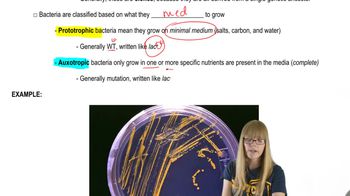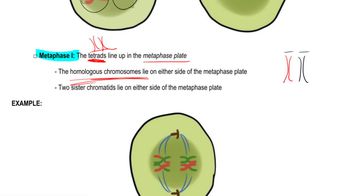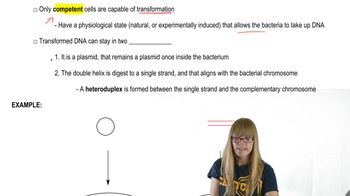Table of contents
- 1. Introduction to Genetics51m
- 2. Mendel's Laws of Inheritance3h 37m
- 3. Extensions to Mendelian Inheritance2h 41m
- 4. Genetic Mapping and Linkage2h 28m
- 5. Genetics of Bacteria and Viruses1h 21m
- 6. Chromosomal Variation1h 48m
- 7. DNA and Chromosome Structure56m
- 8. DNA Replication1h 10m
- 9. Mitosis and Meiosis1h 34m
- 10. Transcription1h 0m
- 11. Translation58m
- 12. Gene Regulation in Prokaryotes1h 19m
- 13. Gene Regulation in Eukaryotes44m
- 14. Genetic Control of Development44m
- 15. Genomes and Genomics1h 50m
- 16. Transposable Elements47m
- 17. Mutation, Repair, and Recombination1h 6m
- 18. Molecular Genetic Tools19m
- 19. Cancer Genetics29m
- 20. Quantitative Genetics1h 26m
- 21. Population Genetics50m
- 22. Evolutionary Genetics29m
5. Genetics of Bacteria and Viruses
Bacterial Transformation
Problem 29a
Textbook Question
A wild-type culture of haploid yeast is exposed to ethyl methanesulfonate (EMS). Yeast cells are plated on a complete medium, and 6 colonies (colonies numbered 1 to 6) are transferred to a new complete medium plate for further study. Four replica plates are made from the complete medium plate to plates containing minimal medium or minimal medium plus one amino acid4 (replica plates numbered 1 to 4) with the following results:
Identify the colonies that are auxotrophic (mutant). What growth information leads to your answer?
 Verified step by step guidance
Verified step by step guidance1
Understand the concept of auxotrophy: Auxotrophic mutants are those that cannot synthesize a particular compound required for their growth and must obtain it from their environment.
Review the experimental setup: Yeast cells are exposed to EMS, a mutagen, and then plated on complete medium where all colonies can grow. Replica plating is used to test growth on minimal medium and minimal medium plus specific amino acids.
Analyze the growth patterns: Check which colonies fail to grow on minimal medium but grow on minimal medium plus one specific amino acid. This indicates that the colony is auxotrophic for that amino acid.
Identify auxotrophic colonies: Compare the growth on minimal medium and minimal medium plus amino acids for each colony. Colonies that only grow on the supplemented medium are auxotrophic.
Summarize findings: List the colonies that are auxotrophic and specify the amino acid they require for growth, based on the growth patterns observed on the replica plates.
Recommended similar problem, with video answer:
 Verified Solution
Verified SolutionThis video solution was recommended by our tutors as helpful for the problem above
Video duration:
5mPlay a video:
Was this helpful?
Key Concepts
Here are the essential concepts you must grasp in order to answer the question correctly.
Auxotrophy
Auxotrophy refers to the inability of an organism to synthesize a particular compound required for its growth, often due to mutations in genes involved in metabolic pathways. In yeast, auxotrophic mutants cannot grow on minimal medium unless the missing nutrient is supplied. Identifying auxotrophic colonies involves observing which colonies fail to grow on minimal medium but can grow when supplemented with specific amino acids.
Recommended video:
Guided course

Bacteria in the Laboratory
Ethyl Methanesulfonate (EMS)
Ethyl methanesulfonate (EMS) is a chemical mutagen that induces mutations in DNA by alkylating bases, leading to mispairing during DNA replication. This process can result in various mutations, including point mutations that may affect metabolic functions. Understanding the role of EMS in creating mutations is crucial for analyzing the resulting yeast colonies and determining which are auxotrophic.
Replica Plating
Replica plating is a technique used to transfer colonies from one agar plate to another, allowing for the comparison of growth under different conditions. In this experiment, colonies from a complete medium are replicated onto minimal medium and minimal medium supplemented with amino acids. This method helps identify auxotrophic mutants by revealing which colonies can grow under nutrient-limited conditions, indicating their metabolic capabilities.
Recommended video:
Guided course

Meiosis Steps

 5:53m
5:53mWatch next
Master Transformation with a bite sized video explanation from Kylia Goodner
Start learningRelated Videos
Related Practice


